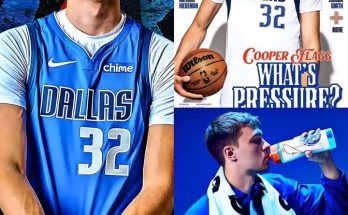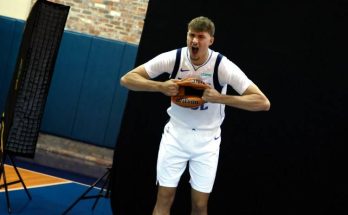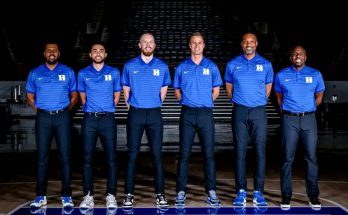The California Classic Summer League entered its second day with high expectations surrounding the San Antonio Spurs and Golden State Warriors clash—a matchup brimming with young talent, budding standouts, and burgeoning narratives. Ultimately, it was the Spurs who emerged victorious in a thriller, edging out the Warriors 90–88 and evening their record at 1–1. The score reflected America’s most fascinating microcosm of perseverance, mixed development drills, and high-stakes performances designed to showcase the next wave of NBA hopefuls.
From the opening tip, the Spurs established their identity—aggressive defense, unwavering focus, and controlled aggression at both ends of the floor. A dominant first quarter—21 points to the Warriors’ 13—sent a clear message: San Antonio was here to compete, not warm seats. Their stifling defense forced Golden State into early turnovers, disrupted the Warriors’ rhythm, and created easy transition opportunities. The bench rotation played with cohesion, signaling the depth the Spurs are quietly building in summer sessions.
David Jones‑Garcia, one of the tournament’s underrated stars, spearheaded that early surge. The undrafted second-year wing turned in a sizzling 25-point performance, hitting multiple three-pointers, driving to the basket, and finishing with a stat line that reflected both chaos and mastery—three rebounds, three assists, three steals—drawing praise as the top performer of the night for the Spurs ([nba.com][1]). His first-half impact wasn’t just scoring; he orchestrated plays, manipulated defenses, and showcased the kind of two-way versatility NBA teams crave. Observers compared his skill set to Harrison Barnes: crafty scoring, solid defense, and dependable perimeter shooting—even if his handle sometimes betrayed him .
As the game progressed, Golden State answered. The Warriors erupted for 33 points in the second quarter, rallying behind explosive moments from their newcomers. Undrafted guard LJ Cryer torched the nets with 19 points, including a barrage of threes, two assists, and a steal . Second-round pick Will Richard also made headlines, pouring in 16 points off the bench, grabbing four rebounds, and adding two steals. Their presence kept Golden State within striking distance all night, ensuring the score remained tight.
Richard’s summer-league debut was particularly noteworthy. He hadn’t practiced with the team since April, and his participation hinged on a newly finalized seven-team trade involving the Warriors, Phoenix Suns, and several other franchises. Despite limited preparation, his poise—especially in late-game pressure—shone through. He drained 8-of-8 free throws and knocked down key triples late in the fourth. His aggressive defense complemented his scoring, demonstrating his readiness at both ends.
Despite the offensive explosion, Golden State struggled with turnovers—22 in total compared to the Spurs’ 18 . Their 3-point shooting, while respectable, couldn’t fully compensate. They finished 31.4% from deep whereas San Antonio posted a stronger 39.3% mark. Field goal efficiency overall favored the Spurs, who converted 47.5% of their shots. Defense and shot return evidently played into the final tally.
San Antonio’s supporting cast also deserves credit. Omari Moore added 13 points, four assists, and a steal—a stat line celebrated by local hype sites as embodying the ideal Spurs guard prototype. Swingman Jameer Nelson Jr. contributed 12 points, while others like Harrison Ingram (8 points, 6 rebounds, 2 steals) and Osayi Osifo (8 points, 5 rebounds) left glimpses of promise nested within their rotations. Their contributions provided San Antonio with the depth necessary to hold off Golden State’s late surge.
The narrative of 21 lead changes and 11 ties told the story of a game teetering on every possession. With less than 30 seconds remaining, Richard hit a clutch triple to narrow the gap to a single point. Moments later, he missed a potential game-winner from beyond the arc—underscoring both his confidence and his rookie-level growing pains . Even so, his assertive play was emblematic of a player eager to establish himself.
Illinois-trained Jules Bernard, a weekend warrior for Golden State, was instrumental in keeping the score tight late. He assisted Richard on one of those critical triples and nailed a mid-range jumper himself . Despite the miss, the Warriors stayed within reach.
As the clock ticked under 10 seconds, both teams held chances. The Spurs drew the final possession; the ball was worked for a quality shot—but it didn’t fall. Golden State secured the rebound and rushed downcourt, unleashing a last-ditch heave that bounced off the rim as time expired. Spurs 90, Warriors 88—San Antonio pulled it off.
On paper, rebounding numbers were surprisingly close: Spurs gathered 27 boards (2 offensive, 25 defensive), while the Warriors snagged 35 (8 offensive, 27 defensive), but Golden State couldn’t capitalize enough to flip the result . Free throws were solid on both sides: the Spurs made 23 of 32 for 71.9%, while Golden State hit 23 of 28 for 82.1% .
Turnovers—critical in close contests—favored San Antonio slightly (18 to 22), underscoring how disciplined decision-making in crunch time becomes gold . Steals (11) vs. Blocks (4) further reflected the Spurs’ defensive edge .
For San Antonio, this win was exactly the shot in the arm they needed after a 98–77 blowout loss to Charlotte, a game where Dominick Barlow and Julian Champagnie dominated. It now positions them at 1–1, with another test looming against the Los Angeles Lakers on Day 3 .
The Warriors, yo-yo-ing between explosive offense and sloppy turnovers, level their record at 1–1. Their next opponent—the Miami Heat—will present a new test for one of summer’s most unpolished yet promising squads .
Zooming out, what this game ultimately showcased was the summer league’s core mission: evaluating player growth, consistency, and responsiveness when the lights shine hot. The depth of the Spurs’ roster surfaced through Jones‑Garcia’s emergence, Moore’s composed play, and an energy core of Ingram and Osifo. Meanwhile, Golden State’s debutants—Cryer, Richard, Mobley—proved capable of high-octane scoring but flagged in possession control and late-game execution.
From a stylistic perspective, San Antonio leaned on veteran summer principles—defense, shot selection, and minimizing turnovers—while Golden State embraced fast-paced shots, occasional risk, and ramped-up tempo. The contrast was instructive: one squad measured and methodical, the other dynamic and electric.
The game also highlighted the unpredictability—and charm—of under-the-radar players shining unexpectedly. Jones‑Garcia, undrafted yet forming a 25-point bomb; Richard, second-rounder denied practice, now forcing late-game attention; Cryer, an overlooked draftee suddenly electrifying. Their performances may not make headlines across ESPN’s nightly recaps, but they hint at the next wave of NBA contributors—role players, surprise breaks, and developmental milestones.
As both teams pivot to Day 3 matchups—the Spurs vs. Lakers, Warriors vs. Heat—the Los Angeles-centered crucible of the California Classic continues. Through these matchups, qualities like resilience, adaptability, and hustle translate into roster hope and contractual momentum. Coaches, scouts, and front offices are taking note, squirreling away moments like Richard’s late triple or Jones‑Garcia’s defensive strip.
In a broader lens, the California Classic embodies more than just televised scrimmage; it’s a summer showcase—accelerated training camp, fan intramural, and economic opportunity for young talents. Games like this one (90–88 thrillers) remind us why the format works: it distills learning, productivity, and entertainment into tight pockets of intensity, providing fans a glimpse of tomorrow’s NBA personalities.
In conclusion, the Spurs’ 90‑88 win over the Warriors on Day 2 of the California Classic wasn’t just a result—it was a narrative generator. It spotlighted emerging talent, contrasted team philosophies, and reinforced basketball’s timeless principle: defense and discipline win tight games. It stamped David Jones‑Garcia as a sleeper to watch, introduced Will Richard’s poise under pressure, and catalyzed summer discussions. It raised the stakes for Day 3. And most importantly, it proved summer league still matters—not for box office draw, but as fertile ground where future rotations are sown, and even one point can echo into next season.
As these teams prepare for their next matchups, they do so enriched—with scouting tape, confidence, and the clarity that comes from testing resolve under fire. That’s what the California Classic delivers. And on this night, San Antonio delivered the headline.


